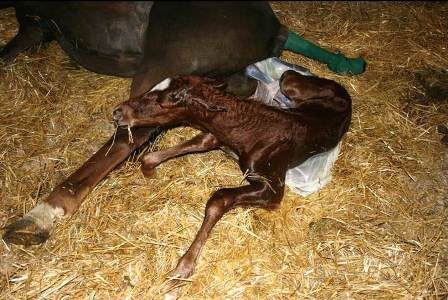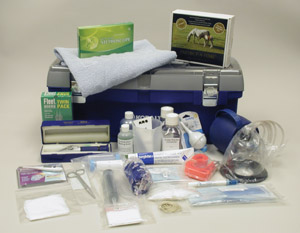 When your mare has made it to 320 days of pregnancy you are in the home stretch and will soon be the proud owner of a newborn foal. Are you ready? While labor and delivery are certainly a significant event, generally all will go off without a hitch and more likely than not, you will need only to be a quiet spectator. It is usually best to allow the mare’s natural instinct and abilities handle the delivery. However, your presence is important in the event of trouble or an emergency so you can call your veterinarian for assistance if it appears your mare is in distress during her foaling. Being knowledgeable of normal labor and delivery will allow for quick action and recognition if abnormal events should occur. There are also a few things to keep in mind in the weeks leading up to her due date that will aid in making for a safe and memorable foaling for you and your equine companions. In this article, we review pre-foaling plans and provide a supply list for your foaling kit.
When your mare has made it to 320 days of pregnancy you are in the home stretch and will soon be the proud owner of a newborn foal. Are you ready? While labor and delivery are certainly a significant event, generally all will go off without a hitch and more likely than not, you will need only to be a quiet spectator. It is usually best to allow the mare’s natural instinct and abilities handle the delivery. However, your presence is important in the event of trouble or an emergency so you can call your veterinarian for assistance if it appears your mare is in distress during her foaling. Being knowledgeable of normal labor and delivery will allow for quick action and recognition if abnormal events should occur. There are also a few things to keep in mind in the weeks leading up to her due date that will aid in making for a safe and memorable foaling for you and your equine companions. In this article, we review pre-foaling plans and provide a supply list for your foaling kit.
Where she will foal?
By this time, you should have decided if your mare will be foaling at a designated breeding station or if you will be handling everything at home. Either way, providing your mare with a proper location to foal is a significant first step in the foaling process. It is highly recommended to have your mare moved into the facility in which you anticipate the foaling to occur at least 30 days prior to her due date. This will allow the mare to become acclimated to her new environment and help her begin to develop antibodies specific to the environment which will be passed along to the newborn foal through the colostrum. Also, keep in mind that the majority of mares will prefer foaling at night, when they are isolated and surroundings are calm, quiet, and dark. Allowing her to feel safe in the environment where she is comfortable enough to lay down is key to a low stress foaling.
Take into consideration your mares breed and size when choosing the location. Be sure to provide a stall that is no less than 14 X 14 feet (14 X 28 feet being ideal) which will allow ample room for mare and foal during and after foaling as well as protection from the elements and wind. It is also important to look at the stall from a foal’s point of view keeping in mind that initially your foal will be awkward and clumsy moving to energetic and  curious in the days to follow. Ensure that there are no nail heads and other sharp points or objects that are not flush with the wall and also that all water and feed buckets are either removable or do not pose a potential hazard during the foaling process or to the foal itself. Finally, while there are multiple bedding choices on the market today, the standard of straw (preferably good quality wheat straw) is by far the best choice for a safe foaling environment. Not only does straw limit the amount of harmful dust and debris your newborn foal is exposed to, it provides natural insulation in chilly temperatures. Following the birth of the foal, it is important to expect that your mare will be protective of her newborn. Give her time to become acquainted with her foal and limit the proximity of other horses if she shows aggressive signs toward protecting the foal.
curious in the days to follow. Ensure that there are no nail heads and other sharp points or objects that are not flush with the wall and also that all water and feed buckets are either removable or do not pose a potential hazard during the foaling process or to the foal itself. Finally, while there are multiple bedding choices on the market today, the standard of straw (preferably good quality wheat straw) is by far the best choice for a safe foaling environment. Not only does straw limit the amount of harmful dust and debris your newborn foal is exposed to, it provides natural insulation in chilly temperatures. Following the birth of the foal, it is important to expect that your mare will be protective of her newborn. Give her time to become acquainted with her foal and limit the proximity of other horses if she shows aggressive signs toward protecting the foal.
Vaccinations and Deworming
A comprehensive health plan for your mare that includes parasite management with anthelmintics (dewormers) and booster vaccinations will set the stage for the health of your newborn foal. Routine dewormings throughout gestation will significantly decrease the newborn foal’s early exposure to parasites. While the majority of available dewormers are approved for use in the pregnant mare, it is important to read the label carefully prior to treating your mare to ensure the safety of the product. The type of anthelmintic and frequency of each dose should be based on the mare’s individual parasite load and farm management. Of particular relevance are the larvae of the intestinal threadworm, Strongyloides westeri. They can migrate to the mammary gland and be passed to the foal through the milk. Strongyloides westeri can cause diarrhea in foals and may predispose the foal to other intestinal problems. It is recommended that the pregnant broodmare receive a dose of paracitacider approximately one month prior to the anticipated due date. Many veterinarians recommend the mare receive additional Ivermectin within 12 hours of delivery to minimize the risk of transferring this parasite. Breeders report that this protocol helps to prevent foal scours.
 Like a good parasiste program, vaccinations are essential to not only the early health and wellbeing of newborn foals but also in providing the mare with her necessary immunologic protection. Vaccinating the mare at 5, 7, and 9 months of pregnancy to prevent Equine Herpes Virus (EHV-1) abortion is vital to the continued health of the pregnancy and unborn foal. Likewise, the other vaccinations your mare will need to receive include Tetanus, Rabies, West Nile Virus (WNV), and Eastern/Western Equine Encephalo-myelitis (EEE/WEE) 4 to 6 weeks before her due date. Some mares also receive risk based vaccines for Influenza, strangles, potomac horse fever and rotovirus. Ensuring that your mare receives these vaccinations will help to provide a necessary level of antibodies that will be passed along to the foal via colostrum. The foal will depend completely on these antibodies for protection during the first months of life, before they begin producing their own antibodies. Be sure to discuss with your veterinarian what works best for your mares’ individual situation.
Like a good parasiste program, vaccinations are essential to not only the early health and wellbeing of newborn foals but also in providing the mare with her necessary immunologic protection. Vaccinating the mare at 5, 7, and 9 months of pregnancy to prevent Equine Herpes Virus (EHV-1) abortion is vital to the continued health of the pregnancy and unborn foal. Likewise, the other vaccinations your mare will need to receive include Tetanus, Rabies, West Nile Virus (WNV), and Eastern/Western Equine Encephalo-myelitis (EEE/WEE) 4 to 6 weeks before her due date. Some mares also receive risk based vaccines for Influenza, strangles, potomac horse fever and rotovirus. Ensuring that your mare receives these vaccinations will help to provide a necessary level of antibodies that will be passed along to the foal via colostrum. The foal will depend completely on these antibodies for protection during the first months of life, before they begin producing their own antibodies. Be sure to discuss with your veterinarian what works best for your mares’ individual situation.
Early Detection
Disruptions to the mare during the early stages of labor may unnerve her enough to cause a delay in the birth. Early detection and monitoring systems along with a careful eye for the subtle signs of labor can help the experience go smoothly. Estimate the length of gestation based on your recorded date of ovulation; the average mare will carry for 320-360 days. It can be exasperating waiting for your mare to show you signs that she will be foaling soon. There are tests that can be performed stall side in which the calcium carbonate level in the mammary secretions are monitored. The FoalWatch Kit by Chemetrics measures the concentration of calcium in the mare's colostrum, which rises sharply when birth is imminent. Monitoring with such test kits begins once or twice a day about 2 weeks before the mare's expected foaling date. In the hours preceding birth, an increase occurs in the content of Calcium in the mammary secretion. When it reaches or exceeds the value of 200ppm (parts per million) the probabilities that birth will happen within 24 hours are of 54%, that it will happen within 48 hours of 84% and within 72 hours of 98%. Likewise, simple pH paper for the values of 5-9 can be very helpful in gauging likely foaling. Mammary secretions have a distinct decrease in pH to below 6.4 when foaling is imminent. Tracking the daily pH of the secretions can provide cost effective and easy monitoring of an impending parturition.
Additionally, there are a number of electronic devices that send an alarm notification to your phone when the mare lies down in the foaling position. Another popular transmitter device called Foalert, is sutured just outside the vulva starting 1 to 2 weeks prior to the mares expected due date or when she begins to show signs such as a distended udder. Towards the end of the first phase of delivery when there is physical separation of the vulva lips, the magnet pulls from the transmitter sending a signal and setting off an alarm. While early detection kits and monitoring systems are beneficial to the foaling process, nothing can or should beat the good eyes of watchful and educated personnel. 
Foaling Kit
No mare is the same when it comes to foaling out, though year after year it is found that mares will follow a similar foaling pattern. That said, it is a good practice to have all the supplies ready well in advance and ideally waiting outside the designated foaling stall. You do not want to be scrambling around when your mare is in labor or be unprepared in the event of an emergency. Some important items to have on hand include:
- Your veterinarians phone number; including an after hour emergency number and it also doesn’t hurt to have a backup veterinarian’s phone number, just in case.
- Brown Gauze or Vet Wrap: To wrap the mares tail prior to foaling
- 1% Chlorhexadine solution & a 12mL syringe case or some other small cup to put solution in: For a naval dip, which should be performed a few times a day for the first day or so
- Fleet Enema (Sodium Phosphate Enema): Administer to foal at 1-2 hours post foaling to help prevent meconium impactions and to stimulate bowel movement
- Clean bath towels: To help dry off and stimulate the foal, initially they have a difficult time regulating temperature on their own so it is also convenient to have a foal sized blanket on hand it colder environments
- Thermometer (Quick read/digital): Monitoring the young foals temperature can give you a heads up should it be harboring some sort of infection
- Stethoscope
- Sharp Scissors: A must have and easily accessible, as in the event of a Red Bag time is everything
- Flashlight with new batteries
- Obstetrical Sleeves/ Latex gloves
- Lubricant
- Ivory Hand soap
- Bucket with warm water
- String: Allow the umbilical cord to break on its own, sometimes though it will need to be tied off to prevent excessive bleeding
Other useful items to have on hand include trash bags, baling twine, a clean baby bottle with nipple, clock or watch, and an extra bale of straw. In some situations it is also good to have some pharmaceuticals on hand. Stored in a safe place, Oxytocin, Banamine, and sedative should be used under the direction and supervision of your veterinarian. A complete foaling kit supply list can be found here.
Nobody wants to experience a dystocia when foaling out their own mare, but remain calm and call your veterinarian immediately. Because most mares will foal at night, you will likely have to leave a message with your veterinarian’s on-call service. Though you may not be feeling it, speak calmly and slowly so that all your information is clear and the veterinarian can get back in touch with you quickly. It can and will seem as though time is moving unbearably slowly when you are waiting for critical events to happen, but being informed and prepared will give you the peace of mind that you are ready at a moment’s notice when your mare begins to foal.
You may also be interested in the following articles:
The Role of the Gut Microbiome in Post-Partum Colic
The Abnormal Foaling...What Can Go Wrong?
Why Colostrum Transfer is Critical to a Foal's First Weeks of Life
Foal Diarrhea - Avoiding it Altogether
Article was updated and revised in February 2020.


Log in to join the conversation.